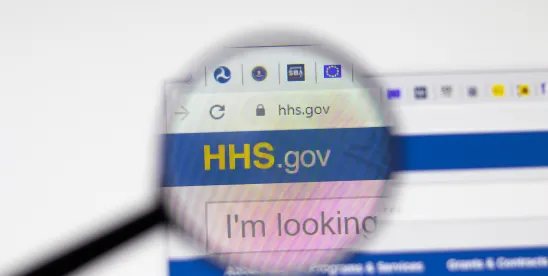Nineteen states plus the District of Columbia filed a federal Complaint in U.S. District Court for the District of Rhode Island on May 5, 2025 alleging that the Trump Administration’s recent activities to downsize and restructure the Department of Health and Human Services (HHS) are unlawful under both the U.S. Constitution and the Administrative Procedure Act (APA). The coalition of states, led by New York, is asking the judicial branch for declaratory and injunctive relief “to prevent the unconstitutional and illegal dismantling of the Department.” In addition to New York and the District of Columbia, states joining the lawsuit comprise Arizona, California, Colorado, Connecticut, Delaware, Hawai'i, Illinois, Maine, Maryland, Michigan, Minnesota, New Jersey, New Mexico, Oregon, Rhode Island, Vermont, Washington, and Wisconsin (together, the Plaintiff States). This is but one among multiple legal challenges to the ongoing programmatic and research cuts within HHS and its sub-agencies, such as the National Institutes of Health, Food and Drug Administration, and Centers for Medicare and Medicaid Services.
In their Complaint, the Plaintiff States emphasize that the department was both created by Congress via statutory enactments and that many of its mandates are congressionally directed, with significant federal appropriations allocated to HHS every year. They point out that “[i]ncapacitating one of the most sophisticated departments in the federal government implicates hundreds of statutes, regulations, and programs.” The plaintiffs allege, therefore, that the restructuring and reduction in force (RIF) actions taken by HHS Secretary Kennedy and the other named defendants, which ignore those statutory mandates and refuse the spend funds appropriated to HHS for designated purposes, violate the U.S. Constitution’s appropriations clause as well as separation of powers principles.
We have previously blogged about HHS’s recent restructuring and RIF actions, as well as the Trump administration’s plans for reducing the overall HHS discretionary budget. In its factual allegations, the Plaintiff States’ Complaint sets out a detailed timeline of actions taken by the Trump administration to dismantle the department, beginning on January 21, 2025 immediately after the presidential inauguration. It also points to the White House Office of Management and Budget (OMB) fiscal 2026 internal HHS budget document, dated April 10 and leaked on April 16 (which we discussed here), as evidence that the administration’s plan from day one of its tenure was to eviscerate the department.
The Plaintiff States further argue that the Trump administration’s actions in this area have been arbitrary and capricious under the APA’s legal standard “because the department’s stated reasons for the layoffs and reorganization – to promote ‘efficiency’ and ‘accountability’ – are pretext for Secretary Kennedy’s stated goal of attacking science and public health.” In support of this contention, the Plaintiff States summarize Secretary Kennedy’s long history of public statements criticizing HHS and various of its public health functions using vitriolic language and baseless claims about global conspiracies.
The Complaint also highlights specific examples of injuries that have already occurred to the Plaintiff States and their citizens as a result of the March 27, 2025 HHS reorganization announcement and the subsequent actions since then to terminate employees, programs, and offices. Among other things, it notes that “employees who remain at HHS have been prevented from collecting and reviewing new applications; designing, distributing, and implementing new policies and guidance; collecting and distributing scientific data; issuing obligated funds to the Plaintiff States and others; investigating for program integrity; and responding to any manner of public inquiry.” One specific example cited in the Complaint relates to the closure of infectious disease laboratories run by the Centers for Disease Control & Prevention (CDC). Without those specialized CDC testing labs, state public health laboratories throughout the country are being directed via CDC’s webpage to send their patient samples to New York State’s Wadsworth Center, which has “elite capabilities” and can test for rare and complex diseases “that cannot be done anywhere else in the country except for the CDC before April 1,” the Plaintiff States explain. However, they point out that the New York lab “was not built to replace the CDC and it simply could never fill that hole.” With a halt to so much testing by CDC, including for widespread public health needs such as foodborne pathogens and tuberculosis, our public health infrastructure is undoubtedly being damaged, and outbreaks will become more frequent. The terminations also are directly at odds with Congress’s legislative directives to CDC to protect the public health.
Throughout U.S. history to date (as we approach the country’s 249-year birthday this coming Independence Day), and as envisioned by the authors of our constitution, the three branches of the federal government are treated as “co-equals,” with due respect accorded to one another and the critical roles each one plays in the delicate balance that is our tri-partite system of federal governance. So, although the federal courts should be an effective way to curtail perceived lawlessness by the executive branch, the current administration has demonstrated a willingness to ignore injunctions and other judicial orders (for example, see here). We will monitor the outcome of this important legal challenge in the Rhode Island District Court, as well as any future appeals. However, it is very possible that the Plaintiff States will not get the relief they are requesting, even if the federal courts agree with them regarding the nature of the executive’s actions to dismantle much of HHS without prior notice to Congress or a chance to ensure that mandatory public health functions can continue.
This very real potential outcome of the federal court litigation strongly suggests that Congress must get involved to exert effective oversight and some form of a “check” on the executive branch if we are to retain many of our nation’s critical health and human services functions. These include critical HIV prevention, environmental health, and tobacco control functions that have been substantially damaged (although ending such programs is seemingly incompatible with much of Secretary Kennedy’s Make America Healthy Again agenda that seeks to reduce the burden of chronic diseases). Health care and life sciences stakeholders can contact their congressional representatives and can also submit comments to any open HHS or OMB docket that affects their interests, rather than relying solely on the outcome of judicial processes, given the extraordinary political times we are experiencing in 2025.




 />i
/>i

